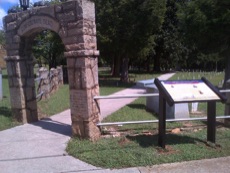
Atlanta Campaign Heritage Trail
®
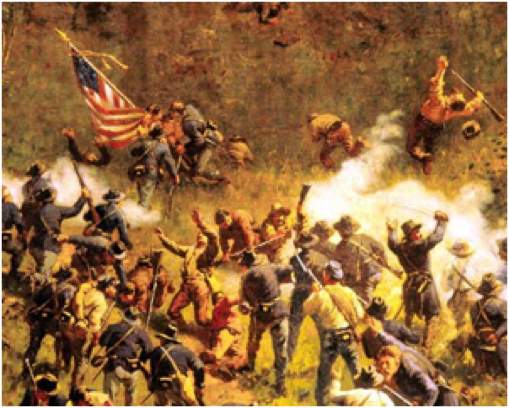
The Campaign for Atlanta
... the story

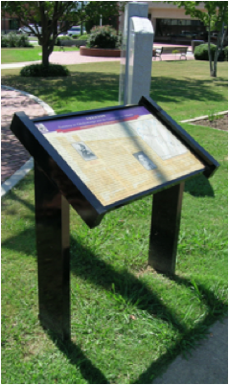
Interpretive marker in Trenton GA on Chickamauga portion of the Atlanta Campaign Heritage Trail®
In early September 1863 the Federal Army of the Cumberland, under Major General William S. Rosecrans, entered northwest Georgia. But Rosecrans’ army retreated to Chattanooga after being defeated on the 19th & 20th at the Battle of Chickamauga by the Confederate Army of Tennessee under General Braxton Bragg. The subsequent Confederate siege ended in late November, following the arrival of Federal reinforcements and a new commander, Major General Ulysses S. Grant, with the defeat of Bragg’s army on Lookout Mountain and Missionary Ridge. The Confederates retreated through Ringgold to Dalton, in position to defend Atlanta. They spent the winter rebuilding morale and preparing for 1864.
The Federal plan for 1864 called for coordination between their main eastern and western armies. This strategy prevented the transfer of Confederate reinforcements to threatened locations, as occurred at Chickamauga. Newly promoted Lieutenant General Grant moved toward Richmond. Simultaneously, his successor in Georgia, Major General William Tecumseh Sherman, aimed to destroy the Confederate army at Dalton, now under General Joseph E. Johnston, and capture Atlanta.
The move toward Atlanta began in early May. The principal supply artery for both armies was the Western & Atlantic Railroad, between Atlanta and Chattanooga. For two months Sherman made numerous flanking movements, designed to cut the railroad. Johnston steadily retreated, giving up land but preserving his smaller army and communications. Sherman first feinted toward Dalton, then pushed through Snake Creek Gap. Johnston moved south to Resaca, where a large battle occurred on May 14 & 15. But when Federal troops crossed the Oostanaula River, Johnston retreated again.
For another week the Confederates continued retreating south, eventually crossing the Etowah River to a strong position at Allatoona Pass. Sherman swept west from the railroad, and again Johnston countered, resulting in three ferocious battles near Dallas, Georgia from May 25 to 28. Sherman returned to the railroad, fighting a series of skirmishes to Kennesaw Mountain, climaxing in a failed Federal assault there on June 27. Superior numbers enabled Sherman to move around Johnston’s flanks, forcing more retreats, finally across the Chattahoochee River to the outskirts of Atlanta.
Frustrated by the retreats, Confederate President Jefferson Davis replaced Johnston on July 18 with General John Bell Hood, an aggressive fighter. Hood immediately struck at Sherman three times, at Peachtree Creek, east of Atlanta, and Ezra Church, but was defeated each time. Finally, on August 31 and September 1 at Jonesboro, Sherman cut the last rail link into Atlanta. Hood’s army retreated south and Atlanta surrendered on September 2. Sherman’s wire, “Atlanta is ours, and fairly won,” secured President Abraham Lincoln’s re-election in November, and the Federal government’s continued military effort to win the war.
Interpretive Marker Sites
Site numbers are as indicated in the
Atlanta Campaign Heritage Trail brochure
NEW - White Oak Gap
1. Trenton
Trenton - A large Federal army first entered Georgia in early September 1863 when Trenton was occupied by part of Union Major General William S. Rosecrans' "Army of the Cumberland."
GPS: 34.8725, -85.5099
2. Davis' Cross Roads
Davis' Cross Roads - Advancing east through mountain passes, Union Major General James S. Negley's large Federal division of the 14th Corps escaped a potentially crushing defeat here when Confederate units three times their number failed to properly coordinate an attack between September 9 & 11, 1863.
GPS: 34.7557, -85.3678
3. Chattooga Academy / John B. Gordon Hall
Chattooga Academy / John B. Gordon Hall - Renamed in 1936 for a former pupil, the Academy was Confederate General Braxton Bragg's headquarters prior to the Battle of Chickamauga in September 1863. It was a Federal commissary in June 1864 when attacked by Confederate cavalry.
GPS: 34.7092, -85.2808
4. Crawfish Spring
Crawfish Spring - During the Battle of Chickamauga on September 18 to 20, 1863, many parched soldiers of both sides drank from its waters. A reunion held here in 1889 helped start the Chickamauga & Chattanooga National Military Park.
GPS: 34.8705, -85.2926
5. Lee & Gordon's Mills
Lee & Gordon's Mills - Built by James Gordon between 1836 and 1857, and operated by his son-in-law J. M. Lee during the Civil War. Fighting occured here during the Battle of Chickamauga in September 1863, and troops on both sides camped near it at various times.
GPS: 34.8832, -85.2677
6. McFarland's Gap
McFarland's Gap - This gap in Missionary Ridge was the primary route of retreat for the Federal army on September 20, 1863 at the end of the Battle of Chickamauga, and a Federal advance route for the Atlanta Campaign in April & May 1864.
GPS: 34.9487, -85.2953
7. The Ringgold Depot
The Ringgold Depot - Damaged by Union Major General Joseph Hooker's artillery during the Battle of Ringgold Gap on November 27, 1863, when Confederate wagons were saved by Major General Patrick R. Cleburne's division.
GPS: 34.9151, -85.1076
8. Tunnel Hill
Tunnel Hill - This Western & Atlantic Railroad tunnel and depot witnessed the “Great Locomotive Chase” on April 12, 1862. The adjacent Clisby Austin House was Union Major General William T. Sherman’s headquarters from May 7 to 12, 1864.
GPS: 34.8398, -85.0417
9. Battle of Mill Creek Gap
Mill Creek Gap - The nearly impregnable Rocky Face Ridge defenses built by the Confederate army on either side of this gap prompted Federal probing attacks from May 8 to 13, 1864, while other Federals were flanking through Snake Creek Gap.
GPS: 34.8013, -85.0120
NEW - Crow Valley
Crow Valley - Between May 9 & 12, 1864, Union Major General John Schofield’s Army of the Ohio (aka 23rd Corps) aggressively probed the entrenched positions here of two Confederate divisions led by Lieutenant General John B. Hood.
GPS: 34.8351, -84.9872
10. Hamilton House
Hamilton House - Built by James Hamilton in 1840, it served as a hospital, then as the headquarters for Confederate Brigadier General Joseph H. Lewis' Kentucky "Orphan Brigade" during the winter of 1863-1864. It is currently a museum.
GPS: 34.7812, -84.9725
NEW - Fort Hill
Fort Hill - After the fall of Atlanta, the Confederate Army of Tennessee briefly returned to Dalton in October 1864, surrounding and forcing the surrender of its largely African-American Federal garrison.
GPS: 34.7724, -84.9613
11. Dalton Confederate Cemetery
Dalton Confederate Cemetery - It contains the graves of more than 400 Confederate plus four Federal soldiers who died in local hospitals. The cemetery includes a Memorial Wall and soldier's statue.
GPS: 34.7684, -84.9792
12. Battle of Dug Gap
Dug Gap Battle Park - A Federal division attacked then withdrew from here as a feint to distract Confederates in Dalton while the Federal "Army of Tennessee" was secretly flanking Dalton by marching south toward Snake Creek Gap.
GPS: 34.7426, -85.0153
13. Snake Creek Gap
Snake Creek Gap - A Federal division attacked then withdrew from here as a feint to distract Confederates in Dalton while the Federal "Army of Tennessee" was secretly flanking Dalton by marching south toward Snake Creek Gap.
GPS: 34.6641, -85.0598
14. Oostanaula River Bridges
Oostanaula River Bridges - Fearing encirclement from flanking Federal troops, Confederate General Joseph E. Johnston's Army of Tennessee secretly crossed the Oostanaula River bridges during the night of May 15-16, 1864, heading south, thus ending the Battle of Resaca.
GPS: 34.5723, -84.9401
15. Calhoun Depot
Calhoun Depot - Built in 1853, it survived the War and is still in use. The depot witnessed both a portion of the 1862 Great Locomotive Chase and the 1864 Atlanta Campaign.
GPS: 34.5023, -84.9531.
NEW - Fort Norton
NEW - The Noble Brothers Foundry
The Noble Brothers Foundry - Founded in Rome by James Noble in 1855, he and his six sons managed the production of approximately 70 cannon and other armaments for the Confederacy.
GPS: 34.2518, -85.1757
16. Allatoona Pass
Allatoona Pass - A natural stronghold, it was bypassed by Federal armies during the Atlanta Campaign.After Atlanta's fall, the Cconfederate army attacked Federal forts here hoping to break General Sherman's railroad supply line from Chattanooga.
GPS: 34.1134, -84.7148
NEW - Dallas
Dallas - The town had just 200 citizens when nearly 170,000 soldiers arrived and fought in or near here for almost two weeks. Many of the scars they left are still present.
GPS: 33.9211, -84.8396
17. Armstrong’s Advance / DeGress Battery
Armstrong’s Advance / DeGress Battery - The Battle of Dallas on May 28, 1864 began here, with Confederates attacking the Federal right flank. DeGress’ battery supported a successful counterattack.
GPS: 33.9071, -84.8288
18. The Orphan Brigade
The Orphan Brigade - A delay in ordering Joseph Lewis’s Kentucky “Orphans” and one additional Confederate brigade to stay in place caused them to attack the well-entrenched Federal 15th Corps.
GPS: 33.9317, -84.8231
19. Battle of New Hope Church
Battle of New Hope Church - Attempting to flank the Confederate army at Allatoona Pass, Federals marched to the southwest. But a Confederate division arrived here first and repulsed their attack.
GPS: 33.9566, -84.7903
20. New Hope Church Cemetery
New Hope Cemetery - During the Battle of New Hope Church many Confederates used tombstones here as shields. The wooded and deep-ditched area became “the Hell Hole” to Federal units.
GPS: 33.9578, -84.7906
21. Kennesaw House
Kennesaw House, Marietta - At this antebellum summer resort, James Andrews and Federal soldiers dressed as civilians met in April 1862 to begin the "Great Locomotive Chase." The hotel was also the headquarters of General Sherman on July 3, 1864. After the war northern visitors wintered here.
GPS: 33.9655, -84.5510
22. Marietta Confederate Cemetery
Marietta Confederate Cemetery postcard, 1912 - More than 3,000 Confederate dead are buried here, representing every Southern state. Burials began in 1863, with other dead moved here in 1866 from various parts of the state. It is the largest Confederate cemetery in Georgia.
GPS: 33.9625, -84.5489
NEW - The Sidney Smith House
23. Andrew J. Cheney House
24. Robert Mable House
25. Battle of Peach Tree Creek
Battle of Peach Tree Creek - After General John B. Hood replaced General Joseph E. Johnston as Confederate commander he quickly attacked here on July 20, 1864 against Union Major General George Thomas's Army of the Cumberland. The result was Confederate defeat and heavy losses.
GPS: 33.8105, -84.4030
26. Peach Tree Creek Crossing
Peach Tree Creek Crossing - Federal artillery positioned here and just below the creek enabled Brigadier General John Newton's division to repulse an attack by three Confederate divisions led by Lieutenant General William J. Hardee during the July 20, 1864 Battle of Peach Tree Creek.
GPS: 33.8178, -84.3889
27. The Hardman Family Cemetery
The Hardman Family Cemetery - This 1820s cemetery containing graves of both masters and slaves was associated with a church which became a field hospital during the Civil War. Near here is the Powell house site where General Sherman had his headquarters on July 19, 1864.
GPS: 33.7953, -84.3097
28. Old DeKalb County Courthouse
Old DeKalb County Courthouse - An earlier courthouse on this site (1847-1898) witnessed Confederate Major General Joseph Wheeler's cavalry attack against Federal supply wagons on July 22, 1864, part of the Battle of Atlanta. The courthouse was the assembly point for numerous other wartime activities.
GPS: 33.7750, -84.2966
29. Battle of Atlanta
30. Fort Walker
Fort Walker - Located at the southeast corner of Atlanta’s defensive perimeter, it was designed by Confederate engineer Lemuel P. Grant. Built primarily with slave labor, the fort is named for Confederate Major General W. H. T. Walker who was killed during the Battle of Atlanta.
GPS: 33.7329, -84.3686
31. Atlanta's Fairground Hospitals
32. Georgia Railroad Freight Depot
Georgia Railroad Freight Depot - Constructed in 1869 to replace the freight depot destroyed by Sherman's army in November 1864, this depot portrays Atlanta as an important transportation hub served by four different railroads. It is among the oldest buildings in downtown Atlanta.
GPS: 33.7516, -84.3889
33. Shrine of the Immaculate Conception
Church of the Immaculate Conception, Atlanta, circa 1864 - Father Thomas O'Reilly convinced Union Major General Henry W. Slocum to spare his church, four others and Atlanta's City Hall in November 1864. In disrepair after the war, a new and larger church was built on the same site between 1869 and 1873.
GPS: 33.7506, -84.3898
34. (deleted)
35. Battle of Ezra Church
Battle of Ezra Church - Another unsuccessful Confederate attack occurred just west of Atlanta on July 28, 1864, with heavy losses almost five times higher than the defenders. The Federals were moving south in order to break the two remaining railroads into Atlanta.
GPS: 33.7534, -84.4373
36. The Extended Siege Lines
The Extended Siege Lines - To shield their two remaining railroad lifelines Confederates extended their entrenchments southwest from their main Atlanta defenses. The Federals built a parallel line of trenches, a porion of which survive nearby.
GPS: 33.7262, -84.4511
37. Battle of Utoy Creek
Battle of Utoy Creek - A Federal attack here to break the Confederate siege line and remaining railroad lifelines failed on August 6, 1864. This result helped convince General Sherman to move most of his armies west and south to Jonesborough.
GPS: 33.7195, -84.4809
38. Battle of Jonesborough
Battle of Jonesborough (aka Jonesboro Depot) - Approximately 24,000 Confederates under Lieutenant General William J. Hardee attacked four Federal divisions on August 31, 1864 between Jonesborough (Jonesboro) and the Flint River two miles to the west. Hardee's failure resulted in the destruction of the last railroad into Atlanta, threatening that city's survival.
GPS: 33.5215, -84.3539
39. Patrick Cleburne Confederate Cemetery
Patrick Cleburne (Memorial) Confederate Cemetery - On September 1, 1864, Sherman's armies overwhelmed Hardee's lone Confederate corps resulting in Atlanta's surrender. Hundreds of the Confederate dead were buried in this cemetery. It is named for a Confederate general who participated in the Battle of Jonesborough (Jonesboro).
GPS: 33.5302, -84.3536
Related Interpretive Marker Sites
Camp Oglethorpe
Camp Oglethorpe - Opened in 1862, this Macon P.O.W. camp housed Federal prisoners of all ranks. By 1864 overcrowding led to many transfers to a new camp at Andersonville with mostly officers remaining here.
GPS: 32.8245, -83.6276
Fort Hawkins
Fort Hawkins - An early 1800s hilltop frontier fort, it was used by Confederate artillery batteries during the July 30, 1864 fight between George Stoneman’s Federal cavalry and the Confederate defenders of Macon.
GPS: 32.8496, -83.6118
Macon Defensive Fortifications
Macon Defensive Fortifications - As Federal armies penetrated further into Georgia, Macon hastily constructed an impressive ring of defensive fortifications. General Sherman largely by-passed the city in 1864, but General Wilson did not in 1865.
GPS: 32.8517, -83.6364
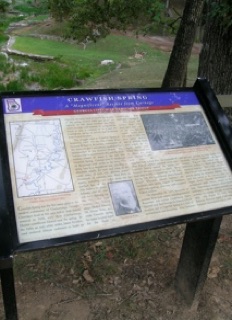
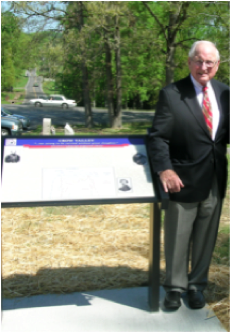
Coach Vince Dooley at dedication of Crow Valley interpretive marker near Dalton, Georgia
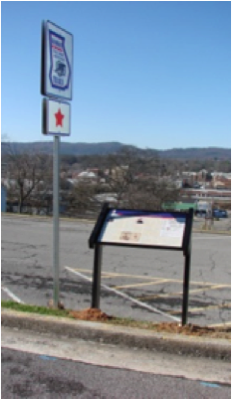
View of Dalton, Georgia from
Fort Hill interpretive marker
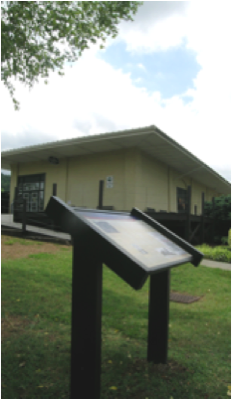
Interpretive marker adjacent to Western & Atlantic Railroad at the Calhoun Depot

Interpretive marker and accompanying "trailblazer" signs
at site of
The Noble Brothers Foundry
in Rome, Georgia.
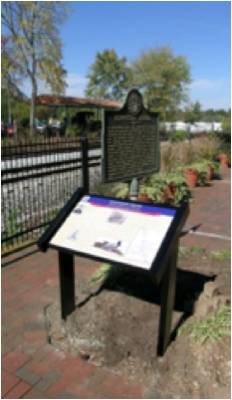
Kennesaw House interpretive marker next to W&A Railroad in
Marietta, Georgia
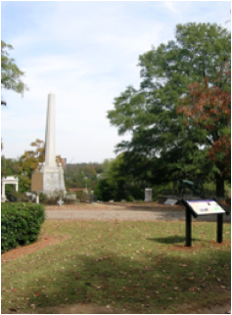
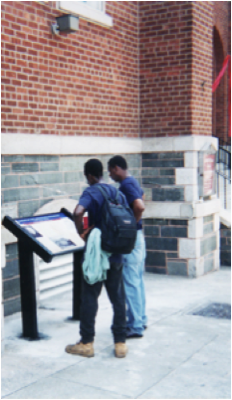
Interpretive marker at
Marietta Confederate Cemetery
Interpretive marker at the
Shrine of the Immaculate Conception in Atlanta, Georgia
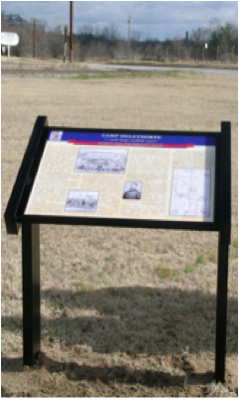
Interpretive marker facing site of Camp Oglethorpe in Macon, Georgia
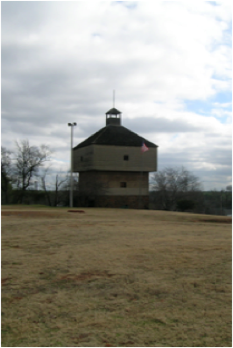
Looking toward Fort Hawkins from its interpretive marker in
Macon, Georgia
Subscribe to Our
"Civil War Heritage Trails"
e-Newsletter
Like This “Atlanta Campaign” Page
Interpretive marker at
Crawfish Spring adjacent to Chickamauga National Military Park
Download: Atlanta Campaign Brochure
Northeast Georgia - Coming Soon
We Will Never Share Your Information!
Unsubscribe Easily.
Interpretive marker at the
Ringgold Depot
New interpretive marker at
Peach Tree Creek Crossing
in Atlanta
Interpretive marker on
Old DeKalb County Courthouse
in Decatur, Georgia
New interpretive marker for the
Battle of Ezra Church
in Atlanta, Georgia
New interpretive marker at
Patrick Cleburne
Confederate Cemetery
in Jonesboro, Georgia
